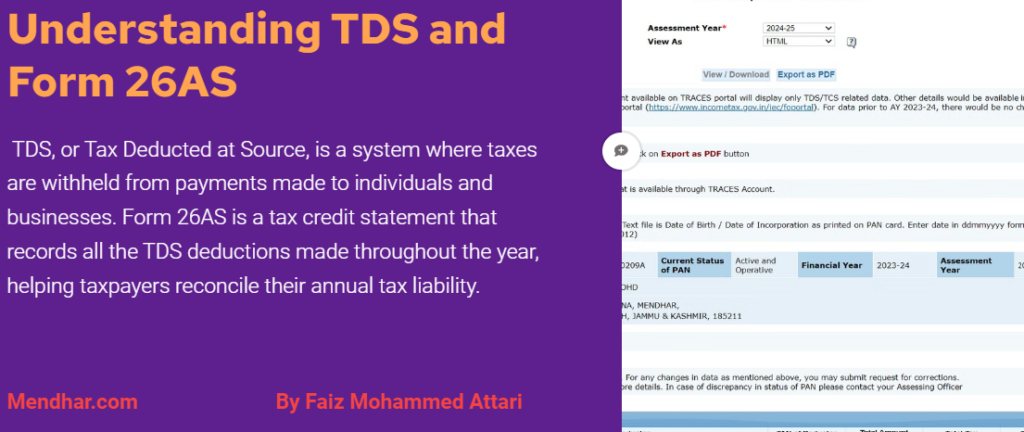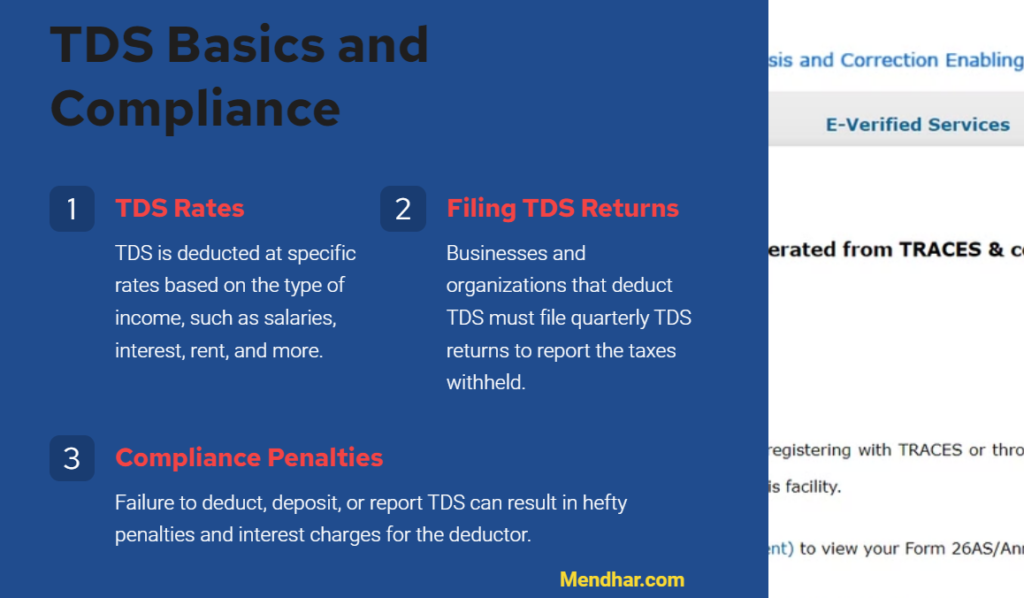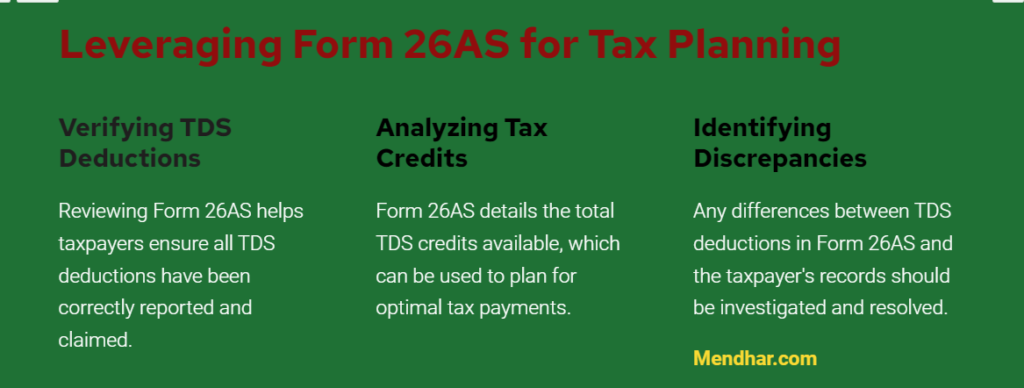Table of Contents
ToggleUnderstanding TDS and Form 26AS: A Comprehensive Guide

Understanding TDS (Tax Deducted at Source)
In the realm of taxation in India, understanding the intricacies of TDS (Tax Deducted at Source) and Form 26AS is crucial for taxpayers. These concepts often cause confusion, but they play a significant role in ensuring compliance and smooth tax transactions. In this comprehensive guide, we’ll delve into what TDS entails, how it works, its implications, and the importance of Form 26AS in the taxation landscape.
TDS, or Tax Deducted at Source, is a mechanism introduced by the Indian Income Tax Department to collect tax at the source of income generation. It requires the payer to deduct tax at specified rates before making payments to the payee. This ensures a steady collection of taxes and prevents tax evasion. TDS is applicable to various types of payments such as salaries, interest, rent, commission, etc.
The payer, often an employer or a financial institution, deducts TDS based on predetermined rates set by the Income Tax Department. These rates vary depending on the nature of the payment and the status of the payee. For example, TDS on salary income follows the tax slab rates applicable to the employee, while TDS on interest income may have fixed rates or exemptions up to a certain threshold.

How TDS Works
To understand how TDS works, let’s consider an example of TDS on salary income. Suppose Mr. A earns a monthly salary of ₹50,000 from his employer. As per the income tax laws, the employer is required to deduct TDS from Mr. A’s salary before making the payment to him. If Mr. A falls under the 20% tax slab, and TDS is deducted at 10%, then ₹5,000 will be deducted as TDS from his salary (10% of ₹50,000). The remaining amount (₹45,000) will be credited to Mr. A’s account.
The deducted TDS is then deposited with the government against Mr. A’s PAN (Permanent Account Number), and the employer issues a TDS certificate (Form 16) to Mr. A, reflecting the details of TDS deducted. Mr. A can claim credit for this TDS while filing his income tax return.
Understanding Form 26AS:
Form 26AS is a consolidated statement issued by the Income Tax Department that contains details of tax credits available to a taxpayer. It serves as a comprehensive record of TDS, advance tax, and self-assessment tax deposited against the taxpayer’s PAN.
Form 26AS can be accessed online through the Income Tax Department’s website by logging into the taxpayer’s account. It is crucial for taxpayers to regularly check their Form 26AS to verify if the TDS deducted and deposited by deductors matches the income earned and the tax liability.
How to download 26AS:
Downloading Form 26AS is a straightforward process facilitated by the Income Tax Department’s online portal. Here’s a step-by-step guide to download Form 26AS:
Visit the Income Tax Department Portal: Go to the official website of the Income Tax Department of India. The URL for the website is https://www.incometaxindia.gov.in.
Login to your Account: If you already have an account on the Income Tax Department portal, login using your credentials. If you don’t have an account, you need to register first.
Navigate to ‘My Account’: After logging in, navigate to the ‘My Account’ section. You can usually find this section on the top-right corner of the website.
Click on ‘View Form 26AS’: Within the ‘My Account’ section, look for the option that says ‘View Form 26AS’. Click on it to proceed.
Select the Appropriate Assessment Year: You will be prompted to select the Assessment Year for which you want to view or download Form 26AS. Choose the relevant Assessment Year from the dropdown menu.
Choose the Type of View: You will typically have two options for viewing Form 26AS: HTML view or Text view. HTML view provides a user-friendly interface, while Text view displays the form in a plain text format. Select the preferred view type.
Authenticate: You may be required to authenticate your identity using one of the authentication methods supported by the Income Tax Department. This could be through Aadhaar OTP, Net Banking, or by answering security questions.
Agree to Consent: Read and agree to the consent terms and conditions provided by the Income Tax Department regarding the usage of Form 26AS data.
View/Download Form 26AS: Once authenticated, you will be able to view or download Form 26AS for the selected Assessment Year. If you wish to download it, there is usually an option to download the form in PDF format.
Save the Downloaded Form: After downloading Form 26AS, save it to your computer or mobile device for future reference or printing.
That’s it! You have successfully downloaded Form 26AS from the Income Tax Department portal. It’s advisable to review the form carefully to ensure that all the TDS details and other tax-related information are accurate and match your records.

Frequently Asked Questions (FAQs) about TDS and Form 26AS:
What is TDS (Tax Deducted at Source)?
- TDS, or Tax Deducted at Source, is a mechanism introduced by the Indian Income Tax Department to collect tax at the source of income generation. It requires the payer to deduct tax at specified rates before making payments to the payee.
Who is liable to deduct TDS?
- Any person or entity making specified payments such as salaries, interest, rent, commission, etc., is liable to deduct TDS as per the rates prescribed by the Income Tax Department.
What are the implications of TDS for the payer?
- The payer is responsible for correctly calculating and deducting TDS at the applicable rates. Failure to comply with TDS provisions can attract penalties and legal consequences.
How does TDS affect the payee?
- TDS affects the cash flow of the payee as tax is deducted upfront before receiving the income. However, it simplifies the tax payment process as a portion of the tax liability is already settled through TDS.
What is Form 26AS?
- Form 26AS is a consolidated statement issued by the Income Tax Department that contains details of tax credits available to a taxpayer. It includes information about TDS, advance tax, and self-assessment tax deposited against the taxpayer’s PAN.
How can I download Form 26AS?
- To download Form 26AS, visit the Income Tax Department portal, log in to your account, navigate to the ‘My Account’ section, select ‘View Form 26AS’, choose the Assessment Year, authenticate your identity, agree to consent, and then view/download the form.
- Related Articles:


Pingback: Understanding Section 89 of Income Tax -